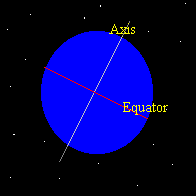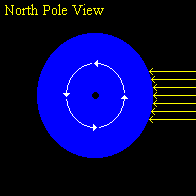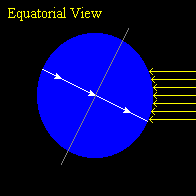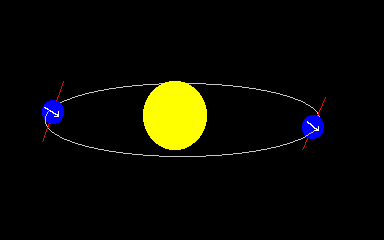

The figures show the suns rays as they impinge on the Earth.



In the northern hemisphere note that the sun in the summer solstice rises in the northeast, moves high across the sky and settles in the northwest.
In the northern hemisphere in the winter solstice the sun rises in southeast, scoots low across the sky and sets in the south west.
There are two important issues here:
The vernal equinox marks the beginning of the spring, when the Sun passes northward through the equatorial plane (Mar 21)
The autumnal equinox marks the beginning of fall, when the Sun passes southward through the equatorial plane (Sept 21)
KEY POINT: The seasons are not the result of a changing Earth-sun distance. The distance actually does vary a little, and the orbit is slightly elliptical but this is a small effect. Note that the closest approach between objects in an orbit is called the perihelion and the farthest point is the aphelion.
The aphelion occurs around July 4 and the perihelion occurs around January 4. Clearly this has very little to do with the seasons.
The effect is very small on day to day, and we don't notice it in our lifetime. However, since the celestial poles and equator are defined with respect to this
The signs of the Zodiac represent the constellations that lie in the plane of the ecliptic. If we could turn off the sun in its fixed position, then the constellation behind it determines the particular Zodiac "sign" of that time of year.
But because of the precession, the original system developed by the Babylonians 2000 years ago is now outdated, though it is still the common one that is used in popular culture and by astrology types.
For example Aries, which represented the sign of the spring equinox then, is not longer an equinox sign. Now it is Aquarius ("the age of Aquarius").
There were some effects I briefly mentioned that I said were small: the precession of Earth's spin axis, the slight ellipticity of the Earth's orbit. Is there any sense in which these effects are important? Possibly:
CLIMATE describes the average weather over decades and centuries. (Weather is what happens on a day to day basis.) It is possible that these slight effects have an influence on the Earth's climate.
Earth has gone through ice ages when worldwide climate was cooler and thick ice covered northern latitudes. Earliest was 5.7 x 10^8 years ago, then 2.8 x 10^8 years ago and then 3 x 10^6 years ago. The effect is somewhat periodic (2.5 x 10^8 year cycles). Cycles of glacial formation within ice ages have cycles of about 4 x 10^4 years. We are now living in a warm period which began 20,000 years ago.
MILANKOVITCH's HYPOTHESIS (1920) suggests that the slight changes in the earth's shape, orbits, precession etc. affect the climate and trigger ice ages.
For example the elliptical shape of the earth's orbit varies over 10^5 years. If the Earth's orbit became more elliptical and approached the sun more closely in the northern winters (winter solstice) then the northern winters would be warmer. Most of the land mass in where ice can accumulate is in the northern hemisphere. Thus we have a possible effect.
The precession of Earth's spin axis also affects when the winters occur with respect to the Earth-sun distance. Again a small effect, but perhaps subtly relevant over 26,000 years.
The inclination of Earth's spin axis to its orbital plane also varies over 40,000 years by about 1 degree. This would make the seasons more severe.
It is, at some level possible to test this. Depth studies of geological concentrations of various elements and gas concentrations in earth's ocean floors are sensitive to the temperature at the period at which the material was deposited. As it builds up in time, one gets a time history of the temperature through subtle differences in concentrations. In short the evidence is uncertain but possible and still being investigated.
Note that all this ignores the fact that the Sun's luminosity changes by a fraction of a percent over various cycles and periods of evolution so it is hard to say what is happening. Same applies for global warming and the greenhouse effect.
This is how science works however. Many effects are considered, and some are ruled out eventually, but extensive testing and modeling is required.
Note the hierarchy of time scales that are playing a role in this business, and their relation to our daily time scales, and that of the universe at large.